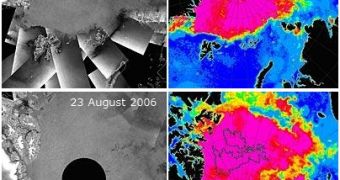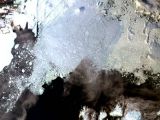The scientists examining satellite images of the North Pole were astonished to detect dramatic openings in the ice. The openings are larger than the British Isles and appeared in the so-called perennial ice - the ice that doesn't normally melt in the summer - north of Svalbard and extending into the Russian Arctic all the way to the North Pole. Researchers discovered that 5 to 10 percent of the Arctic perennial ice has fragmented by late summer storms.
"This situation is unlike anything observed in previous record low ice seasons. It is highly imaginable that a ship could have passed from Spitzbergen or Northern Siberia through what is normally pack ice to reach the North Pole without difficulty," said Mark Drinkwater from the European Space Agency's Oceans/Ice Unit. "If this anomaly trend continues, the North-East Passage or 'Northern Sea Route' between Europe and Asia will be open over longer intervals of time, and it is conceivable we might see attempts at sailing around the world directly across the summer Arctic Ocean within the next 10-20 years."
The scientists used data gathered by the Envisat's Advanced Synthetic Aperture Radar (ASAR) instrument and by the AMSR-E instrument aboard the EOS Aqua satellite. ASAR is an active microwave instrument which sends periodic radar pulses toward the Earth and measures the signals return. AMSR-E is a passive microwave instrument which does not send radar pulses down but receives radiation naturally emitted from the Earth.
Researchers found that a large area, located between Spitzbergen, the North Pole and Severnaya Zemlya, has much lower ice concentrations than during earlier years. This seems to be part of a general trend. The satellites have been monitoring the Arctic for the past 25 years. The surface covered by ice during the summer, when the ice-sea is the smallest, has been gradually shrinking. In early 1980s, it measured around 8 million square km; in 2005 a historic minimum of less than 5.5 million square km was recorded.
Besides the fact that the ice sea is shrinking rapidly, scientists have now revealed that it also becomes more mobile and thin. The black and white images on the left are taken by Envisat ASAR (Courtesy of Polar View). The right colored images are from EOS Aqua AMSR-E ice concentration acquired on the same day (Courtesy of Leif Toudal Pedersen).
In the colored AMSR-E images, ice cover, or the concentration of ice, is represented by the color. Pink represents pack ice and the color blue open water. Intermediate colors orange, yellow, and green indicate lower ice concentrations of 70%, 50% and 30%, respectively. In the ASAR images, the ice cover is represented by the uniform grey area which extends radially-outwards from the North Pole, represented by the central black circle.
The 2006 images show fractures and openings in the sea-ice cover - just below the pole in both the ASAR image, seen as splashes of dark grey and black, and in the AMSR-E image (with British Isles shown for scale), seen by the high concentration of yellow, orange and green colors, signifying low ice concentrations.
In the last weeks, the open water has begun to freeze, as the autumn air temperatures over the Arctic begin to fall. "As autumn freeze-up begins, the current pattern will undoubtedly precondition the ice situation in the Central Arctic for the subsequent ice season," Drinkwater said.
This 29 August 2006 Envisat MERIS image highlights the area North of Svalbard, Norway, where a very low sea ice concentration can be seen. The image width is about 800 km. (Credits: ESA)

 14 DAY TRIAL //
14 DAY TRIAL // 
